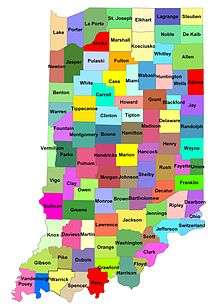Lynching of Thomas Shipp and Abram Smith

Thomas Shipp and Abram Smith were African American men who were lynched on August 7, 1930, in Marion, Indiana, after being taken from jail and beaten by a mob. They had been arrested that night as suspects in a robbery, murder and rape case. A third African American suspect, 16-year-old James Cameron, had also been arrested and narrowly escaped being killed by the mob; he was helped by the intervention of an unknown woman and returned to jail. He was later convicted and sentenced as an accessory before the fact. After dedicating his life to civil rights activism, in 1991 he was pardoned by the state of Indiana.[1]
The local chapter of the NAACP and the State's Attorney General struggled to indict some of the lynch mob, but no one was ever charged for the murders of Shipp and Smith, nor the attack on Cameron.[2]
Incident
The three suspects had been arrested the night before, charged with robbing and murdering a white factory worker, Claude Deeter, and raping his white girlfriend, Mary Ball, who was with him at the time.
A large crowd broke into the jail with sledgehammers, pulled out the three suspects, beating them and hanging them. When Abram Smith tried to free himself from the noose as his body was hauled up, he was lowered and men broke his arms to prevent any other efforts to free himself. Police officers in the crowd cooperated in the lynching. A third person, 16-year-old James Cameron, narrowly escaped death after being strung up, thanks to an unidentified woman who said that the youth had nothing to do with the rape or murder.[3] A local studio photographer, Lawrence Beitler, took a photograph of the dead men hanging from a tree surrounded by the large lynch mob; it included women and children. He sold thousands of copies of the photograph in the next ten days.[4]
Mary Ball later testified that she had not been raped. According to Cameron's 1982 memoir, the police had originally accused all three men of murder and rape. After the lynchings, and Mary Ball's testimony, the rape charge was dropped.
James Cameron was tried in 1931 as an accessory before the fact, convicted and sentenced to state prison for several years. After being released on parole, he moved to Detroit, worked and went to college. In the 1940s he worked in Indiana as a civil rights activist and headed a state agency for equal rights. In the 1950s he moved to Wisconsin. There in 1988 he founded America's Black Holocaust Museum, for African-American history.[1]
Mrs. Flossie Bailey, a local NAACP official, and the State Attorney General worked to gain indictments against leaders of the mob in the lynchings, but were unsuccessful. No one was ever charged in the murders of Shipp and Smith, nor the assault on Cameron.[2]
Legacy
- The night of the lynching, studio photographer Lawrence Beitler took a photograph of the crowd by the bodies of the men hanging from a tree. He sold thousands of copies over the next 10 days, and it has become an iconic image of a lynching.
- In 1937 Abel Meeropol, a Jewish schoolteacher from New York City and the adoptive father of the sons of Julius and Ethel Rosenberg, saw a copy of Beitler's 1930 photograph. Meeropol later said that the photograph "haunted me for days" and inspired his poem "Bitter Fruit". It was published in the New York Teacher in 1937 and later in the magazine New Masses, in both cases under the pseudonym Lewis Allan. Meeropol set his poem to music, renaming it "Strange Fruit". He performed it at a labor meeting in Madison Square Garden. In 1939 it was performed, recorded and popularized by American singer Billie Holiday.[5] The song reached 16th place on the charts in July 1939, and has since been recorded by numerous artists, continuing into the 21st century.
- After years as a civil rights activist, in 1988 James Cameron founded and became director of America's Black Holocaust Museum in Milwaukee, Wisconsin, devoted to African-American history in the United States. He intended it as a place for education and reconciliation.
- In 2007, artist David Powers supervised the creation of a mural, titled American Nocturne, in a park in downtown Elgin, Illinois. The mural depicts the bottom half of the Beitler photograph, showing the crowd at the lynching but not the bodies of Shipp and Smith.[6] The artwork was intended as a critique of racism in American society.[7] In 2016 there was a public controversy when the similarity between the mural and the photo was posted on social media. The mural was moved from the park to the Hemmens Cultural Center.[8] The Elgin Cultural Arts Commission then recommended to the city council that the mural be permanently removed from public display.[6]
Notes
- 1 2 James Cameron Holocaust Museum founder, African American Registry, 2006, accessed 15 July 2008
- 1 2 Monroe H. Little, Review of James Madison's A Lynching in the Heartland, History-net, accessed 11 June 2014
- ↑ Cameron discussed these events in his memoir, A Time of Terror (1982). Relevant passages are quoted in several of the "External links" below, including photo notes from the book and website, Without Sanctuary and Legends of America. Other accounts are in James Madison's book, A Lynching in the Heartland, listed in the "Further reading" section below.
- ↑ "Lawrence Beitler, a studio photographer, took this photo. For ten days and nights he printed thousands of copies, which sold for fifty cents apiece." from A Time of Terror, quoted in Legends of America, see previous note. See also Lynching in the Heartland, chapter 6, which discusses the photograph in detail.
- ↑ Holiday's autobiography credits her with co-authoring the song, but other sources say Meeropol wrote his own music. "Strange Fruit", Independent Lens, PBS
- 1 2 Walker, Janelle (June 14, 2016). "Elgin Arts Commission Recommends Removing Mural from Public Display", Chicago Tribune. Retrieved June 15, 2016.
- ↑ Walker, Janelle (May 19, 2016). "Racism 'Abhorrent and Awful' Says Mural Artist", Chicago Tribune. Retrieved May 21, 2016.
- ↑ Casas, Gloria (May 21, 2016). "City Crew Removes, Relocates Controversial Downtown Mural", Chicago Tribune. Retrieved May 21, 2016.
Further reading
- Allen, James; Hilton Als, et al., Without Sanctuary: Lynching Photography in America (Twin Palms Publishers, 2000). Related website of the same name is listed below.
- Bailey, Amy Kate and Stewart E. Tolnay, Lynched. The Victims of Southern Mob Violence (University of North Carolina Press, 2015). ISBN 978-1-4696-2087-9.
- Cameron, James. A Time of Terror: A Survivor’s Story, (Black Classics Press, 1982/reprint 1994).
- Carr, Cynthia, Our Town: A Heartland Lynching, A Haunted Town, and the Hidden History of White America, (Random House, 2007).
- Madison, James. A Lynching in the Heartland: Race and Memory in America (New York: St. Martin’s Press, 2000). ISBN 0-312-23902-5.
- Myrdal, Gunnar. An American Dilemma, (Harper and Brothers, 1944).
- Tolnay, Stewart E. and E. M. Beck, A Festival of Violence: An Analysis of Southern Lynchings, 1882-1930 (Urbana: University of Illinois Press, 1992)
External links
- "Strange Fruit: Anniversary of A Lynching", National Public Radio, includes larger version of original Beitler photo, showing women in the crowd around the hanging bodies
- James Allen, Without Sanctuary: Photographs and Postcards of Lynching in America, his website related to his published book of same name
- Notes on the photo from Allen's Without Sanctuary, includes a quote from Cameron's A Time of Terror
- American History: "Lynching", Spartacus Educational, includes an account of the origin of poem/song Strange Fruit
- Lynchings & Hangings in American History
- A 2005 interview with James Cameron, the survivor, Milwaukee Journal Sentinel, July 8, 2005. (link may require free registration)


